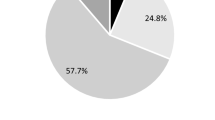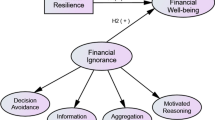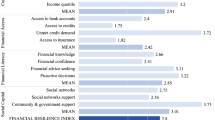Abstract
Financial inclusion has become a policy priority. For many countries, this has meant focusing on the delivery and practical aspects of financial products and services. This paper argues that this approach is not sufficient to improve financial wellbeing more broadly. It suggests a more comprehensive approach moving away from asking whether people are excluded or not to asking whether they have access to accessible, acceptable and appropriate resources and supports in adverse financial circumstances. A better understanding of individuals’ financial resilience: how they bounce back from adverse financial events and the resources and supports they draw on; could help determine where resources can and should be invested to assist people to cope with financial adversity, assist the development of effective policy and, ultimately, improve financial wellbeing. This paper puts forward a definition of financial resilience and a methodology for measuring it. Australia is used as a case country from which to draw conclusions using a survey of 1496 representative adults (18+). The findings indicate that over 2 million Australian adults experienced severe or high levels of financial vulnerability raising very real concerns about financial wellbeing. Implications for academics and policy makers are presented.





Similar content being viewed by others
Notes
Some questions required a simple yes/no response while others a graded response. Note that several questions require an element of ‘self-assessment’ by the respondent and, while this is a normal approach in surveys, it does have some limitations.
These groups all had significantly different financial resilience scores compared to the overall population (p < 0.01).
References
Abbott-Chapman, J., Denholm, C., & Wyld, C. (2008). Social support as a factor inhibitting teenage risk-taking: views of students, parents and professionals. Journal of Youth Studies, 11(6), 611–627.
Adger, W. (2000). Social and ecological resilience: are they related? Progress in Human Geography, 24, 347–364.
Akter, S., & Mallick, B. (2013). The poverty-vulnerability-resilience nexus: Evidence form Bangladesh. Ecological Economics, 96, 114–124.
Anderloni, L., & Vandone, D. (2008). Households over-indebtedness in the economic literature. Milan: State University of Milan.
Australian Bureau of Statistics (2015). Table 10: All household, selected household characteristics by age of household reference person. Housing occupancy and costs, 2013–2014 (cat. no. 4130.0).
Australian Council of Social Service. (2014). Poverty in Australia 2014. Strawberry Hills: Australian Council of Social Services.
Blaikie, P., Cannon, T., Davis, I., & Wisner, B. (1994). At risk: Natural hazards, people’s vulnerability, and disasters. New York: Routledge.
Bonanno, G. (2005). Clarifying and extending the construct of adult resilience. Amercian Psychologist, 60, 265–267.
Briguglio, L., Cordina, G., Farrugia, N., & Vella, S. (2008). Economic vulnerability and resilience: Concepts and measurements. Helsinki: UN University World Institute for Development Economics Research.
Buikstra, E., Ross, H., King, C. A., Baker, P. G., Hegney, D., McLachlan, K., et al. (2010). The components of resilience—perceptions of an australian rural community. Journal of Community Psychology, 38(8), 975–991.
Burkett, I., & Sheehan, G. (2009). From the margins to the mainstream: The challenges for microfinance in Australia. Spring Hill: Foresters Community Finance.
Cassells, R., Duncan, A., & Ong, R. (2016). Gender equity insights 2016: inside Australia’s gender pay gap. BCEC|WGEA Gender Equity Series, Issue #1, March 2016.
Cnaan, R. A., Moodithaya, M. S., & Handy, F. (2012). Financial inclusion: Lessons from rural South India. Journal of Social Policy, 41, 183–205. https://doi.org/10.1017/S0047279411000377.
Conger, R. D., & Conger, K. J. (2002). Resilience in Midwestern families: Selected finding from the first decade of a prospective, longitudinal study. Journal of Marriage and Family, 64(2), 361–373.
Connolly, C., Georgouras, M., Hems, L., & Wolfson, L. (2011). Measuring financial exclusion in Australia. Sydney: Centre for Social Impact-University of New South Wales for National Australia Bank.
Consumer Financial Protection Bureau (2018). Pathways to financial well-being: The role of financial capability. United States Government.
Council of Social Service of New South Wales (2014). Cost of living—who’s really hurting? Sydney: Council of Social Service NSW Report.
Cull, R., Ehrbeck, T., & Holle, N. (2014). Financial inclusion and development: Recent impact evidence. Focus note no. 92. Washington, D.C.: CGAP.
Cummins, R. A. (2010). Subjective wellbeing, homeostatically protected mood and depression: A synthesis. Journal of Happiness Studies, 11(1), 1–17.
Cutter, S. L., Barnes, L., Berry, M., Burton, C., Evans, E., Tate, E., et al. (2008). A place-based model for understading community resilience to natural disasters. Global Environmental Change, 18, 598–606.
Demiguc-Kunt, A., Klapper, L.F., Singer, D., & Van Oudheusden, P. (2015). The global Findex database 2014: Measuring financial inclusion around the world. World Bank Policy Research Working Paper (7255).
Department for International Development (2011). Defining disaster resilience: A DFID approach paper. http://www.dfid.gov.uk/Documents/publications1/Defining-Disaster-Resilience-DFID-Approach-Paper.pdf. Accessed February 2016.
Donnellan, B., Conger, K. J., McAdams, K. K., & Neppl, T. K. (2009). Personal characteristics and resilience to economic hardship and its consequences: conceptual issues and empirical illustrations. Journal of Personality, 77(6), 1645–1676.
Ensel, W. M., & Lin, N. (1991). the life stress paradigm and psychological distress. Journal of health and social behaviour, 32, 321–341.
Finney, A. (2016). Defining, measuring and predicting financial capability in the UK: Technical report. Social Research and Statistics.
Folke, C. (2006). Resilience: The emergence of a perspective for social-ecological analyses. Global Environmental Change, 16, 253–267.
Gallopin, G. C. (2006). Linkages between vulnerability, resilience, and adaptive capacity. Global Environmental Change, 16, 293–303.
Gomez-Barroso, J. L., & Marban-Flores, R. (2013). Basic financial services: A new service of general economic interest? Journal of European Social Policy, 23(3), 332–339. https://doi.org/10.1177/0958928712471226.
Gunderson, L. (2009). Comparing Ecological and human Community Resilience. CARRI Research Report 5: Community and Regional Resilience Initiative.
Hallegatte, S. (2014). Economic resilience: Definition and measurement. C. C. G. The World Bank, Office of the Chief Economist.
Holling, C. S. (1973). Resilience and stability of ecological systems. Annual Review of Ecology and Systematics, 4, 1–23.
Huston, S. J. (2010). Measuring financial literacy. The Journal of Consumer Affairs, 44(2), 296–316.
Jacobs, D., Perera, D., & Williams, T. (2014). Inflation and the cost of living. Sydney: Bulletin: Reserve Bank of Australia.
Janssen, M. A., Schoon, M. L., Ke, W., & Borner, K. (2006). Scholarly networks on resilience, vulnerability and adaptation within the human dimensions of global environmental change. Global Environmental Change, 16, 240–252.
Kempson, E., & Poppe, C. (2018). Understanding financial well-being and capability—A revised model and comprehensive analysis. Oslo: Oslo Metropolitan University: Consumption Research Norway—SIFO.
Kessler, R. C., Green, J. G., Gruber, M. G., Sampson, N. A., Bromet, E., Cuitan, M., et al. (2010). Screening for serious mental illness in the general population with the K6 screening scale: Results from the WHO World Mental Health (WMH) survey initiative. International Journal of Methods in Psychiatric Research, 19, 4–22.
Lepore, S., & Revenson, T. (2006). resilience and posttraumatic growth: recovery, resistance, & reconfiguration. In L. Calhoun & R. Tedeschi (Eds.), The handbook of posttraumatic growth: research and practice. Mahwah: Erlbaum.
Leyshon, A., & Thrift, N. (1995). Geographies of financial exclusion: Financial abandonment in Britain and the Untied States. Transactions of the Institute of British Geographers, 20(3), 312–341.
Lusardi, A., & Mitchell, O. S. (2014). The economic importance of financial literacy: Theory and evidence. Journal of Economic Literature, 52(1), 5–44.
Lusardi, A., Mitchell, O. S., & Curto, V. (2010). Financial literacy among the young. The Journal of Consumer Affairs, 44(2), 358–380.
Manyena, S. B. (2006). The concept of resilience revisited. Disasters, 30(4), 433–450.
Masten, A. S. (2001). Ordinary magic: Resilience processes in development. Amercian Psychologist, 56, 227–238.
McAteer, M. (2014). Developing financial resilience. T. F. I. Centre.
Morduch, J., & Schneider, R. (2017). The financial diaries: How American families cope in a world of uncertainty. Princeton: Princeton University Press.
Morrow, B.H. (2008). Community resilience: A social justice perspective. CARRI Research Report 4. C. A. R. R. Initiative.
Muir, K., & Strnadova, I. (2014). Whose responsibility? Resilience in families of children with developmental disabilities. Disability and Society, 29(6), 922–937.
Muir, K., Marjolin, A., & Adams, S. (2015). Eight years on the Fringe: What has it meant to be severely or fully financially excluded in Australia? Sydney: Centre for Social Impact for the National Australia Bank.
Muir, K., Reeve, R., Connolly, C., Marjolin, A., Salignac, F., & Ho, K. -A. (2016). Financial resilience in Australia 2015. Sydney: Centre for Social Impact for the National Australia Bank.
Norris, F.H. (2010). Behavioral science perspectives on resilience. CARRI Research Report 10: Community and Regional Resilience Institute.
Organisation for Economic Co-operation and Development (2014). PISA 2012 results: Students and money: Financial literacy skills for the 21st century (volume VI). Programme for International Student Assessment.
Orthner, D. K., Jones-Sanpei, H., & Williamson, S. (2004). The resilience and strengths of low-income families. Family Relations, 53(2), 129–167.
Pant, R., Barker, K., & Zobel, C. W. (2014). Static and dynamic metrics of economic resilience for interdependent infrastructure and industry sectors. Reliability Engineering & System Safety, 125, 92–102. https://doi.org/10.1016/j.ress.2013.09.007.
Salignac, F., Muir, K., & Wong, J. (2016). Are you really financially excluded if you choose not to be included? Insights from social exclusion, resilience and ecological systems. Journal of Social Policy, 45(2), 269–286. https://doi.org/10.1017/S0047279415000677.
Scheir, M. F., Carter, C. S., & Bridges, M. W. (1994). Distinguishing optimism from neuroticism (and trait anxiety, self-mastery, and self-esteem): A reevaluation of the life orientation test. Journal of Personality and Social Psychology, 67(6), 1063–1078.
Schicks, J. (2010). Microfinancance over-indebtedness: Understanding its drivers and challenging the common myths. Bruxelles: Centre Emilee Bergheim, Solvay School of Business, CEB Working Paper 10 (p. 048).
Schoon, I., & Bynner, J. (2003). Risk and Resilience in the life course: implications for interventions and social policies. Journal of Youth Studies, 6(1), 21–31.
Seccombe, K. (2002). “Beating the odds” versus “changing the odds”: Poverty, resilience, and family policy. Journal of Marriage and Family, 64(2), 384–394.
Serido, J., Shim, S., & Tang, C. (2013). A developmental model of financial capability: A framework for promoting a successful transition to adulthood. International Journal of Behavioural Development, 37(4), 287–297.
Shehu, A. Y. (2012). Promoting financial inclusion for effective anti-money laundering and counter financing of terrorism (AML/CFT). Crime, Law and Social Change, 57(3), 305–323. https://doi.org/10.1007/s10611-011-9351-0.
Stumm, Sv, O’Creevy, M. F., & Furnham, A. (2013). Financial capability, money attitudes and socioeconomic status: Risks for experiencing adverse financial events. Personality and Individual Differences, 54, 344–349.
Tadele, F., & Manyena, S. B. (2009). Building disaster resilience through capacity building in Ethiopia. Disaster Prevention and Management: An International Journal, 18(3), 317–326. https://doi.org/10.1108/09653560910965664.
Taylor, M. (2011). Measuring financial capability and its determinants using survey data. Social Indicators Research, 102(2), 297–314.
Twenge, J. M., & Campbell, K. W. (2002). Self-esteem and socioeconomic status: A meta-analytic review. Personality and Social Psychology Review, 6(1), 59–71.
Acknowledgements
This work was supported by the National Australia Bank.
Author information
Authors and Affiliations
Corresponding author
Additional information
Publisher's Note
Springer Nature remains neutral with regard to jurisdictional claims in published maps and institutional affiliations.
Rights and permissions
About this article
Cite this article
Salignac, F., Marjolin, A., Reeve, R. et al. Conceptualizing and Measuring Financial Resilience: A Multidimensional Framework. Soc Indic Res 145, 17–38 (2019). https://doi.org/10.1007/s11205-019-02100-4
Accepted:
Published:
Issue Date:
DOI: https://doi.org/10.1007/s11205-019-02100-4




